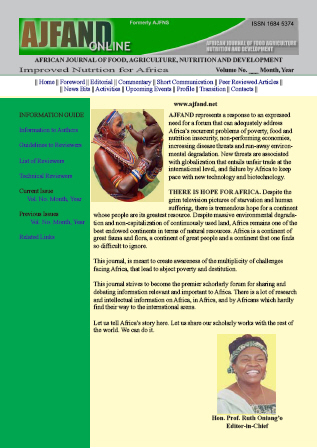
|
African Journal of Food, Agriculture, Nutrition and Development
Rural Outreach Program
ISSN: 1684-5358
EISSN: 1684-5358
Vol. 11, No. 2, 2011, pp. 4647 - 4663
|
 Bioline Code: nd11017
Bioline Code: nd11017
Full paper language: English
Document type: Research Article
Document available free of charge
|
|
|
African Journal of Food, Agriculture, Nutrition and Development, Vol. 11, No. 2, 2011, pp. 4647 - 4663
| en |
Evaluating Post Harvest Opportunities And Constraints To Utilization And Marketing Of African Leafy Vegetables In Cameroon
Berinyuy, J.E. & Fontem, D.A.
Abstract
A rapid production and market appraisal was undertaken to target important markets, commodities, producers and traders of vegetables (exotic and indigenous) in three regions of Cameroon. For each vegetable, post harvest losses were estimated and gross marketing margins were calculated and then used to estimate daily earnings. The main actors were women of between 17 and 50 years old with an average daily earning of less than 1 000 FCFA (US$1 = 495 FCFA). The typical market woman sold 2.5 different products with a mean daily earning of 525 FCFA per product and a total daily earning of 893 FCFA. By groups, sellers of exotic vegetables, such as tomato and cabbage, earned significantly (p<0.001) more than those of indigenous vegetables. Although earnings from huckleberry were comparable with those from exotic vegetables, its production was still traditional, based on indigenous knowledge or on knowledge borrowed from other staple crops and used little or no external inputs. There were no commercial indigenous vegetable seed producers. The diffusion and effectiveness of the indigenous vegetable seed system depended largely on the quality of the variety to be diffused, kinship relationships, and the existence of a culture for agricultural experimentation. Post harvest systems for all vegetables were rudimentary leading to heavy losses (11% and higher) as most vegetables were sold fresh. No storage facilities were available but opportunities exist in drying vegetables using available low cost solar technology thereby offering a chance to increase the value of the seasonal surplus and earning extra income. Complex and stable trading networks existed for selling vegetables, especially for more commercial crops such as huckleberry. The study indicated that indigenous vegetables can be a viable source of income for rural women and can contribute to poverty alleviation, but post harvest procedures need to be established for the handling and marketing of leafy vegetables.
Keywords
indigenous, vegetables, marketing, processing, women
|
| |
© Copyright 2011 African Journal of Food Agriculture, Nutrition and Development.
Alternative site location: http://www.ajfand.net/
|
|
